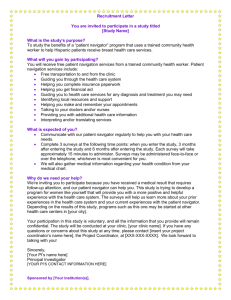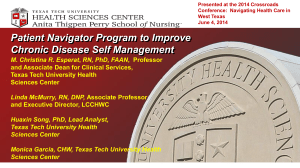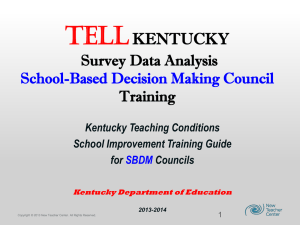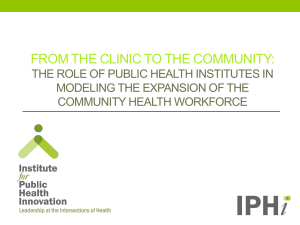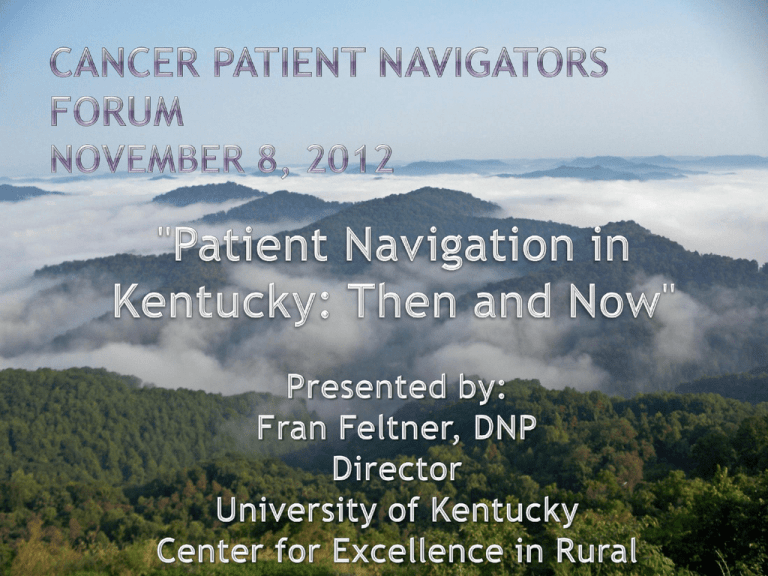
Our Mission
Working to improve the
health of Kentucky’s
rural people through
education, research,
service and community
engagement.
Bailey-Stumbo Building, Hazard, KY
UK Center for Excellence in Rural Health
www.kyruralhealth.org
Introduction
Problems
Identified
Why Patient Navigation is Needed
Past/Present Programs Highlighted
Overview of Progress Made
Outcomes/Results
Today’s Community Health Workers
Navigators Roles
Q&A/Discussion
Access
to the Health Care System
Lack of Understanding of How to Navigate
the Health Care System
Uninsured/Underinsured/Underserved
Transportation
Access to Primary Provider
Access to Medications
Health Literacy
Education on Illness
Communication (culture)
http://www.dailyyonder.com/number-ruraluninsured-grows-recession/2012/10/01/4489
High
rates of obesity
Low levels of physical activity
Poor nutrition
Lack of preventative health services
High rates of smoking
7
Transportation
•
•
Out-of-County residents
No one to bring patient
Medical Bills
•
Under-insured or no insurance
Medication
•
•
Co-Pays
No Insurance
Availability + Access ≠ Utilization
G. H. Friedell, M.D.
May 2, 1994
Mountain SC-Outs Program
Specially-trained female staff
One-on-one interviews
Counties with high cervical
cancer rates
Informed women about
options for early cancer
detection services.
KY HOMEPLACE HISTORY
In the early 1990’s many rural Kentuckians were going
without health care services, and in particular,
preventive care.
The Commonwealth’s General Assembly took the
unique step in 1994 of earmarking taxpayer money
for Kentucky Homeplace.
KENTUCKY HOMEPLACE
Mission
The mission of Kentucky Homeplace is to provide
access to medical, social, and environmental
services for the citizens of the Commonwealth.
Vision/Goals Statement
To educate Kentuckians to identify risk factors
and use preventative measures to become a
healthier people with knowledge and skills to
access the healthcare and social system.
“Patient Navigators coordinate a patient’s
individual care, and serve as invaluable resources
for patients and their caregivers, who might
otherwise be discouraged by a variety of barriers.”
“No person with cancer should be forced to spend
more time fighting their way through the
healthcare system than fighting their disease.”
http://www.cancerpatientnavigation.org/toolkit.
html
Gil Friedell, M.D. Who can be navigators?
“Patient navigators may be community health
workers, lay health educators, peer health
promoters, medical assistants or nurses who
serve as liaison between patients and providers
to promote health among groups that may lack
access to adequate health care.
The purpose of a Patient Navigator is to help
reduce health care disparities; facilitate
communication between patients and providers;
assist patients in overcoming barriers to care;
shape perceptions individuals may have about
disease and specific health-related behaviors;
provide outreach services and educational
support; and offer culturally and linguistically
competent assistance”.
Mental
Health Outreach
Southeast Kentucky Community Access
Program
Health Buddies
Colon Cancer Prevention and Screening
Marcum & Wallace Memorial Hospital
Emergency Room Navigator
ARH/UK Markey Affiliate Cancer Center
Patient Navigator Program
“Outreach and Education for
Colorectal Cancer Screening Using
CHW’s”
Homeplace CHWs enrolled 637 clients in a colorectal
cancer prevention study.
Results:
The mean score of the 637 participants increased from 4.27 at
baseline to 4.57 at follow-up (p<.001).
Clients showed increased awareness and asked physicians
about colorectal cancer screening from 27.6% at baseline to
34.1% at follow-up (p=.013),
(Fetlner, Ely, Whitler, Gross & Dignan, 2012).
This joint effort involved
Hazard Appalachian Regional Hospital,
ARH, Affiliate Markey Cancer Center
UK Center for Excellence
in Rural Health
Kentucky Homeplace
Kentucky-ARH
Affiliate Markey Cancer Center
New Orleans-Mary Bird Perkins Cancer Center
California-Long Beach Todd Cancer Institute
Washington-Providence Hospital
New York-Ralph Lauren Cancer Center
To
implement patient navigation programs in
sites across the United States.
Patient navigation would target the
medically underserved
with the aim of reducing the time interval
between abnormal cancer finding, diagnostic
resolution, and treatment initiation.
Findings
Average
Benign
5,023
Cancer
26
Follow-up
1,237
time between suspicious findings and
diagnostic conformation:
17.4 days (year prior to navigator-30 days)
Average time between diagnosis and treatment:
10.5 days (year prior to navigator-45 days)
Findings
Average
Benign
2,157
Cancer
35
Follow-up
1,027
time between suspicious findings and
diagnostic conformation:
1.7 days
(year prior to navigator - 6 days)
Average time between diagnosis and treatment:
10.8 days
(year prior to navigator- 61 days)
“…the patients come here
with cancer however there
are so many other life
issues they have such as the
electric bill they can’t pay,
or the food they don’t have.
In the area we serve, many
of our patients are not only
fighting cancer, they are
also battling poverty.”
"Patient Navigation for Breast and Colorectal
Cancer in Three Community Hospital
Settings: An Economic Evaluation" (CNCR-112298.R2)
Conclusions:
Implementing breast or
colorectal cancer patient navigation in
community hospital settings serving lowincome populations could be a cost-effective
addition to standard cancer care in the US.
Current Programs
Kentucky Homeplace
Improving Diabetic Outcomes
sponsored through a gift from the Anthem
Foundation
Appalachian Lung Cancer Research
Initiative of the Markey Cancer Center
Lotts Creek Community School Wellness
Program
Determine effectiveness of nurse-led
diabetes self management education
program (DSME) coordinated by CHWs
with client sample population
characterized by high rates of diabetes
and significant health disparities.
30
Recruit study participants
• Administer study instruments
• Support nurse led-DSME
• Enhance DSME curriculum
• Home visit
•
Assess clients’ living environments
Reinforce role of family members’ support
for diabetes self-management
31
Initial
Assessment/Measurements
Body Mass Index (BMI)
A1C
Random Glucose
Blood Pressure
Foot Assessment
32
Education
Module- Based on “Take Charge of
Your Diabetes”, a CDC publication.
Overview
Nutrition
Activity/Exercise
Self-Testing Glucose Levels
Hypo/Hyperglycemia Prevention
Complications/Secondary Diseases
33
Lung Cancer Incidence Rate (age adjusted, 2006)
Appalachia (KY) 107.58 per 100,000
Kentucky
100.82 per 100,000
US
62.5 per 100,000
Counties with “high” lung cancer rates :
5th Congressional District
83%
remainder of Kentucky
38%
Cancer
Prevention
and Control
College of
Agriculture
Statistical
coordination,
geospatial
analysis
Soil, water and
GPS coordinates
College of
Public
Health
Trace element
analysis
MCC Lung
Cancer Initiative:
Epidemiologic
Environmental
& Biologic Data
Live cell
NER analysis
Radon and Nicotine
Data collection
Kentucky
Homeplace
Redox
and
Repair
College of
Nursing
?
CHWs are known by a variety of names,
including community health worker,
community health advisor, outreach
worker, community health
representative (CHR), promotora/
promotores de salud (health
promoter/promoters), patient navigator,
navigator promotoras (navegadores para
pacientes), peer counselor, lay health
advisor, peer health advisor, and peer
leader.
Addressing Chronic Disease through Community Health Workers: A POLICY
AND SYSTEMS-LEVEL APPROACH
A POLICY BRIEF ON COMMUNITY HEALTH WORKERS National Center for
Chronic Disease Prevention and Health Promotion Division for Heart
Disease and Stroke Prevention
Patient navigation is a process by which an
individual—a patient navigator—guides
patients with a suspicious finding (e.g. test
shows they may have cancer) through and
around barriers in the complex cancer care
system to help ensure timely diagnosis and
treatment.
•A problem solver and a highly
resourceful individual.
•A navigator can be a: Trained health
care professional (social worker,
nurse)
•Lay individual who can coordinate
the needed health care services
A Community Health Worker, (CHW) is a frontline public health
worker who is a trusted member of and/or has an unusually close
understanding of the community served.
This trusting relationship enables the CHW to serve as a
liaison/link/intermediary between health/social services and the
community to facilitate access to services and improve the quality
and cultural competence of service delivery.
A CHW also builds individual and community capacity by increasing
health knowledge and self-sufficiency through a range of activities
such as outreach, community education, informal counseling, social
support, and advocacy.1[p.1]
http://www.apha.org/advocacy/policy/policysearch/default.htm?id=1393
Patient navigation in cancer care refers to the assistance offered
to healthcare consumers (patients, survivors, families, and
caregivers) to help them access and then chart a course through
the healthcare system and overcome any barriers to quality care.
A patient navigator can be a registered nurse or a social worker
who functions as a “guide.”
Navigators help their patients move through the complexities of
the healthcare system—getting them more timely treatment,
more information about treatment options and preventive
behaviors.2[p.1]
http://www.apha.org/advocacy/policy/policysearch/default.htm?id
=1393
“The changing landscape of the U.S. population, which is growing
older and more diverse, coupled with other challenges—the
increasing complexity of the health care system, rising health care
costs, growing numbers of uninsured, more people with chronic
diseases, and provider shortages—have policymakers looking for
ways to extend the already strained health care system and more
effectively reach underserved communities”.
“In response, states are examining how community health workers
(CHWs) can connect underserved populations with health and
human service providers. Although the CHW concept is not new,
states and other health care providers are partnering more often
with these workers to help individuals navigate a complex health
care system, receive primary and preventive care, maintain healthy
behaviors, and manage chronic conditions in culturally and
linguistically relevant ways”.
BY Kristine Goodwin and Laura Tobler April 2008
The United States Department of Labor, Bureau of
Labor Statistics now recognizes and has classified the
Community Health Worker title in category 21-1094.
The job duties are described as: community health
workers assist individuals and communities to adopt
healthy behaviors. Conduct outreach for medical
personnel or health organizations to implement
programs in the community that promote, maintain,
and improve individual and community health. May
provide information on available resources, provide
social support and informal counseling, advocate for
individuals and community health needs, and provide
services such as first aid and blood pressure
screening. May collect data to help identify
community health needs. Excludes "Health Educators"
(21-1091).
http://www.bls.gov/soc/2010/soc211094.htm
Increase
access to dental, behavioral,
medical care and social needs
Increase the rates of screenings and followup resulting in better health outcomes
Reduce health disparities by facilitating
communication between patients and
providers
Assist patients to overcome barriers
Affect
Health and Social Policy
Provide Advocacy
Provide Research Opportunities To Reach
Health Disparities/Vulnerable Populations
Recruit Study Participants
Administer Survey Instruments
Visit us online
www.kyruralhealth.org
Appalachian Regional Commission, April 2011; Accessed
April 11, 2012. Available at www.arc.gov
Goodwin K, Tobler L. Community health workers:
expanding the scope of the health care delivery
system. National Conference of State Legislatures.
2008, April; Available at
http://www.ncsl.org/print/health/CHWBrief.pdf. ,
Accessed February 10, 2011.
U.S. Department of Health & Human Services, Health
Resources and Services Administration, Bureau of
Health Professions. Community health worker
national workforce study. March 2007; Accessed
February 10, 2011. Available at
http://bhpr.hrsa.gov/healthworkforce/chw/Appalach
ian Regional Commission, April 2011; Accessed April
11, 2012. Available at www.arc.gov

